The Alchemical Process of Transformation by Nigel Hamilton part 1
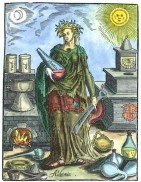
The Origins of Alchemy Alchemy traces its roots back to the Egyptian civilisation where it emerged as a practising art and science and an expression of the Egyptian religion. Thus it was that the Egyptian Thoth, the god of mathematics and science, became the inspirational source for the Hellenistic figure of Hermes Trismegistus, who in turn became the model for the medieval Mercurius. The Greeks learned their Alchemy in the fourth century BC, whilst in Egypt. Several Greek philosophers, scientists, and mystics were initiated into the ancient Egyptian mysteries at this time. The Alchemists of the Middle Ages learnt their art from the Arabs in Spain and Southern Italy, who in turn had adopted it from the Greeks. Thus it was that by the twelfth and thirteenth centuries alchemy had already appeared in Western Europe via Sicily and Spain. Typical places of study were at the Universities of Palermo, Toledo, Barcelona, and Segovia. Understanding Transmutation as the Basis of Alchemy. Alchemy is best known for its belief that lead can be transmuted into gold. However, the transmutation of non-precious metals into gold is simply a metaphor for the soul being freed from a "dead, leaden state of mind," to that of realising its own light nature and that is derived from pure spirit. The alchemists believed that the basis of the material world was a Prima Materia, or prime chaotic matter, which might be actuated into existence if impressed by "form." The "forms" arose in the shape of the elements, earth, water, fire, and air. The Alchemists deduced that the limitless varieties of life were created out of the blending of the elements in particular proportions. Aristotle distinguished the four elements from one another by the four qualities of fluidity, dryness, heat and cold. Each element possesses two of these primary qualities. Thus the four possible combinations are:
hot + dry --> fire
hot + fluid (or moist) --> air
cold + fluid --> water
cold + dry --> earth
One of the two qualities predominates in each element. In earth, dryness; in water, cold; in air, fluidity; in fire, heat. Transmutation is thus possible. Any element may be transformed into another through the quality that they have in common. Thus fire can become air through the medium of heat, just as air can become water through the medium of fluidity. Also two elements may become a third element by removing one quality from each. By parting with the dry and cold qualities, fire and water can become air; by parting with the hot and fluid qualities, the same elements can give rise to earth. Consider the simple example of the transmutation process a piece of green wood undergoes when heated. Drops of water form at the cut end of the wood, therefore wood contains water; steam andvapours are then given off, therefore wood contains air; the wood then burns, demonstrating the fire element; and when we see that only ash is left we realise that the wood contains earth. Alchemists viewed other materials, particularly metals, in much the same way, i.e. that a metal owes its specific form of nature to its specific proportioning of the four elements.
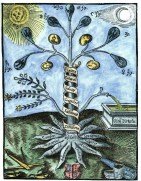 A modern day review of the psychological states and problems that clients present with also shows the presence of the elements, but in distorted proportions; e.g. an over-stressed mind could be described alchemically as excess fire (hot + dry). Nature tries to intervene by releasing water (tears), thereby relieving the overheated mind which could then "cool off." However, more often than not our will interferes and we block the tears, thereby increasing the stress. A similar theory, derived from the theory of the four elements, was the sulphur-mercury theory. This theory presented the two opposed or contrary elements, fire and water, in a new way. Fire became "sulphur" and water "mercury," the former being composed of the primary qualities of hot and dry, the latter of the primary qualities of cold and moist. In general, sulphur stood for the property of combustibility, or the spirit of fire, and mercury for that of the fusibility or the mineral spirit of metals. When sulphur and mercury united in different proportions and in different degrees of purity, the various metals and minerals took shape, according to the sulphur-mercury theory. If sulphur and mercury were perfectly pure, and if they combined in the most complete equilibrium, the product would be the most perfect of metals, namely gold. Defects in purity and, particularly, in proportion, resulted in the formation of silver, lead, tin, iron, or copper. But, since these inferior metals were essentially composed of the same constituents as gold, the accident of combination might be rectified by suitable treatment and by means of elixirs. Now we do not have to adopt the medieval alchemists' view of the physical world, but instead by interpreting it metaphorically, we can extract two very important a priori postulates which formed the basis of alchemical reasoning: 1. The unity of nature as expressed by the idea of the prima materia from which all bodies were formed and into which they might again be dissolved and 2. The existence of a potent transmuting agent capable of promoting the change of one kind of material into another. This imagined agent became known as the "philosopher's stone," the most famous of all alchemical ideas. If we view the prima materia, the original state of matter, as being the original, pure, raw state of consciousness, from which all states of consciousness emerged, i.e. mineral, vegetable, animal, and human, and if we view the philosopher's stone as the state of illuminated consciousness whilst in the earthly body, then both the above premises become useful to our work in psychotherapy. Now apart from a few of the most enlightened alchemists, most practitioners in medieval times believed that they could literally transform lead into gold. The literature shows that the frustrated would-be goldmakers became entangled in a subterranean labyrinth of fantasies, hallucinations, visions, and dreams. Thus, what appeared to be the greatest mistake of the majority of "alchemical hopefuls" turned out to condition their greatest achievement: in the darkness of their blind alley the "sons of Hermes" had come to discover, through their activated imaginations, the unconscious. Carl Jung discovered that many of the dreams and states of consciousness that his clients reported corresponded remarkably to the descriptions recorded in the alchemical texts. Jung subsequently felt that the knowledge of Alchemy could be used in understanding the process of psychological and spiritual transformation as a tool for use in psychotherapy.
A modern day review of the psychological states and problems that clients present with also shows the presence of the elements, but in distorted proportions; e.g. an over-stressed mind could be described alchemically as excess fire (hot + dry). Nature tries to intervene by releasing water (tears), thereby relieving the overheated mind which could then "cool off." However, more often than not our will interferes and we block the tears, thereby increasing the stress. A similar theory, derived from the theory of the four elements, was the sulphur-mercury theory. This theory presented the two opposed or contrary elements, fire and water, in a new way. Fire became "sulphur" and water "mercury," the former being composed of the primary qualities of hot and dry, the latter of the primary qualities of cold and moist. In general, sulphur stood for the property of combustibility, or the spirit of fire, and mercury for that of the fusibility or the mineral spirit of metals. When sulphur and mercury united in different proportions and in different degrees of purity, the various metals and minerals took shape, according to the sulphur-mercury theory. If sulphur and mercury were perfectly pure, and if they combined in the most complete equilibrium, the product would be the most perfect of metals, namely gold. Defects in purity and, particularly, in proportion, resulted in the formation of silver, lead, tin, iron, or copper. But, since these inferior metals were essentially composed of the same constituents as gold, the accident of combination might be rectified by suitable treatment and by means of elixirs. Now we do not have to adopt the medieval alchemists' view of the physical world, but instead by interpreting it metaphorically, we can extract two very important a priori postulates which formed the basis of alchemical reasoning: 1. The unity of nature as expressed by the idea of the prima materia from which all bodies were formed and into which they might again be dissolved and 2. The existence of a potent transmuting agent capable of promoting the change of one kind of material into another. This imagined agent became known as the "philosopher's stone," the most famous of all alchemical ideas. If we view the prima materia, the original state of matter, as being the original, pure, raw state of consciousness, from which all states of consciousness emerged, i.e. mineral, vegetable, animal, and human, and if we view the philosopher's stone as the state of illuminated consciousness whilst in the earthly body, then both the above premises become useful to our work in psychotherapy. Now apart from a few of the most enlightened alchemists, most practitioners in medieval times believed that they could literally transform lead into gold. The literature shows that the frustrated would-be goldmakers became entangled in a subterranean labyrinth of fantasies, hallucinations, visions, and dreams. Thus, what appeared to be the greatest mistake of the majority of "alchemical hopefuls" turned out to condition their greatest achievement: in the darkness of their blind alley the "sons of Hermes" had come to discover, through their activated imaginations, the unconscious. Carl Jung discovered that many of the dreams and states of consciousness that his clients reported corresponded remarkably to the descriptions recorded in the alchemical texts. Jung subsequently felt that the knowledge of Alchemy could be used in understanding the process of psychological and spiritual transformation as a tool for use in psychotherapy.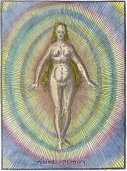
Projection and Unconscious Imagery in Alchemy The work of the alchemist was a slow, laborious one in which free association, projections, and visions of the unconscious occurred not only in their dreams but also whilst staring into their furnaces and working with their equipment. Some examples of this follow: Hoghelande recounts: "They say that different names are given to the stone on account of the wonderful variety of figures that appear in the course of the work, inasmuch as colours often come forth at the same time, just as we sometimes imagine in the clouds or in the fire strange shapes of animals, reptiles or trees. I found similar things in a fragment of a book ascribed to Moses. When the body is dissolved, it is there written, then will appear sometimes two branches, sometimes three or more, sometimes also the shape of reptiles; on occasion it also seems as if a man with a head and all his limbs were seated upon a cathedra." Raymond Lully writes: "You should know, dear son, that the course of nature is turned about, so that without spiritual exaltation you can see certain fugitive spirits condensed in the air in the shape of diverse monsters, beasts, and men, which move like the clouds hither and thither." Finally in Waites' "Introitus apertus" he writes: "The substance of the vessel will exhibit a great variety of forms; it will become liquid and again coagulate a hundred times a day; sometimes it will present the appearance of fishes' eyes and then again of tiny silver trees with twigs and leaves. Whenever you look at it you will have cause for astonishment, particularly when you see it all divides into beautiful but very minute grains of silver, like the ray of the sun. This is the whole tincture..."
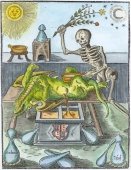
These examples show the imaginary nature of psychological and spiritual phenomenon. The practice of alchemy changed profoundly in Europe from the 12th century, when it was first introduced by the Arabs, to the 16th century, when the alchemical laboratories evolved into psychological laboratories and the alchemical work into explorations of the inner universe. The purgations and transformation of metals were translated into symbolic procedures concerned with the purgation and transformation of souls. Thus the meeting between the alchemists and the unconscious had a revolutionary impact on the alchemical work, which by the end of the Middle Ages had begun to develop into a systemised mystical process of transformation, known as the opus alchymicum. However, with the emergence of the rational spirit in the 17th century, the science of chemistry destroyed the basic concepts and theories of alchemy and replaced them with a rational system from which our science of chemistry has arisen. It was not until the 20th century and the emergence of Depth Psychology that the way was paved for Alchemy to re-emerge and take its place as a source of knowledge that could inform and influence the teaching and practice of psychotherapy. The Contribution of Alchemy to Modern Psychotherapy Modern studies of alchemy, the most notable being Jung's "Psychology and Alchemy", have changed our understanding and interpretation of dreams. In 1946 his work on the "Psychology of the Transference Interpreted in Conjunction with a set of Alchemical Illustrations" revealed a very different light on transference in psychotherapy, which until the time of this publication was influenced mainly by the writings of Sigmund Freud, i.e. that transference was simply a phenomenon that reflected the influence of the parent-child relationship. Jung's work on alchemy showed instead that the transference dreams and experiences of his clients were principally concerned with an inner process of individuation. This process does of course acknowledge the importance of the experience of bonding with and separating from the parental figures, but it also goes way beyond this by envisaging life as a continual process of development. Thus the projections of the clients onto the therapist reflect something of their own inner psychic world rather than Freud's view that the client was basically experiencing the therapist as a parent figure. The greatest contribution that alchemy makes to psychotherapy is its understanding of the process of transformation. It is applicable on the one hand to the simple process of undergoing a change in the way we see the world and at the other end of the scale it provides vital background knowledge to the understanding of the process of spiritual transformation. Jung's texts "Alchemical Studies" (1931 - 54) and "Mysterium Coniunctionis" (1956) are classical studies on the subject of Symbolism and Alchemical Process of Transformation.
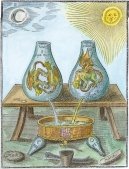


3 Comments:
Words are not enough to write comments on this page. This page is PURE GOLD.
I Simply highly oblize to you.
You page has given me TIMELY help.
-Manish Soni from India.
is alchemy really true?
Bless You. I value my energy spent and in reading your journal I waisted none. Thank you for the countless days and nights put into your words. I ask that the energy trapped within the intent of my words provide added vibrational energy, in the form of amplification, to be be used as you see fit, to excelerate your light transformation process and your changing into a magickal being. From his day forward your words will carry greater distances and your voice will be heard louder. Your hand power has already increased along with your conection to the ALL, feel their power, feel their vibration. You are Stronger. We are thankful. Blessed be you on your path of awakening. This is my will. This is my intent. Thank you. I love you.
Unknown Priest of Light
Teacher of the Alchemy ways
Post a Comment
<< Home